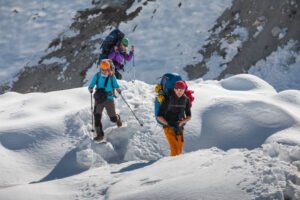The window for embarking on the Chandrashila Tungnath trek packages stretches from April to November. During these months, the weather is pleasant, and the trails are clear, providing optimal conditions for your journey. Spring (April-June) offers vibrant blooming rhododendrons and clear skies, while the post-monsoon season (September-November) boasts crisp views of the snow-laden peaks. For those seeking a winter wonderland experience, December to March presents a snow-covered trail, but be prepared for the challenges and necessary gear to conquer the elements.
Conquering Chandrashila: Essential Preparations
- Physical Fitness:
– Ensure you’re in good physical condition by incorporating regular cardio and strength training exercises into your routine. The trek demands endurance and stamina, so proper preparation is crucial.
- Packing Smart:
– Pack light but efficiently, including warm clothing layers, sturdy trekking shoes, a raincoat, a first-aid kit, and ample food and water to keep you fueled throughout your adventure. A trekking pole can be a valuable aid for the steeper sections of the trail.
- Permits and Registrations:
– Research any necessary permits or registrations required for the Chandrashila trek and obtain them from local authorities beforehand to ensure a smooth and hassle-free experience.
A Once-in-a-Lifetime Experience Awaits
The Chandrashila trek packages offer more than just a hike; they promise a journey of self-discovery that brings you closer to nature and spirituality. From the serenity of Deoria Tal to the vibrant meadows of Chopta, the sacred Tungnath temple, and the awe-inspiring Chandrashila summit, every step is an unforgettable experience etched into the fabric of your memories. So, lace up your boots, pack your bags, and get ready to unravel the magic of Chandrashila – a breathtaking odyssey in the heart of the Himalayas that will leave an indelible mark on your soul.
Discover the Enchanting Beauty of the Deoria Tal Trek
Nestled in the embrace of the Garhwal Himalayas, the Deoria Tal trek beckons adventurers with its mesmerizing allure. Deoria Tal, a pristine high-altitude lake situated at an elevation of 7,999 feet, mirrors the majestic Chaukhamba peaks, creating a spellbinding reflection that leaves onlookers in awe. This trek offers a delightful adventure, combining breathtaking vistas, serene landscapes, and a touch of mythology, making it a perfect choice for both novice and seasoned trekkers alike. Here’s a detailed guide to the enchanting Deoria Tal trek.
Starting Point: Sari Village
The journey to Deoria Tal commences at Sari Village, a quaint hamlet nestled about 12 kilometers away from Ukhimath. Sari serves as the base camp for the Deoria Tal trek and is easily accessible by road from major towns like Haridwar and Rishikesh. The village is enveloped in lush greenery, offering a glimpse into the traditional Himalayan way of life.
The Trek: Sari to Deoria Tal
The trek from Sari to Deoria Tal is a relatively short and easy hike, covering a distance of approximately 2.3 kilometers. The well-marked trail gently ascends through dense forests of oak and rhododendron, serenaded by the melodious chirping of birds and the crisp mountain air. The moderate incline makes it suitable for families, beginners, and even children.
As you approach Deoria Tal, the trail opens up to reveal the stunning lake, surrounded by verdant meadows. The sight of the crystal-clear water reflecting the towering Chaukhamba peaks is truly awe-inspiring. Camping by the lake is a popular activity, allowing trekkers to fully immerse themselves in the serene beauty of the area.
Mythological Significance
Deoria Tal holds a special place in Hindu mythology. It is believed to be the same lake where the Pandavas were asked questions by Yaksha (a nature spirit) during their exile, as mentioned in the Mahabharata. The lake’s tranquil setting and mythical association add a layer of spiritual depth to the trekking experience.
Flora and Fauna
The Deoria Tal trek offers a rich tapestry of biodiversity. The forests are home to a variety of flora, including oak, pine, and rhododendron trees, which bloom with vibrant colors in spring. Wildlife enthusiasts may be fortunate enough to spot animals such as deer, foxes, and a diverse array of bird species. The area is also renowned for its rich butterfly population, adding a splash of color to the verdant landscape.
Best Time to Visit Deoria Tal
The best time to undertake the Deoria Tal trek is from March to June and September to November. During these months, the weather is pleasant, and the skies are clear, providing excellent views of the surrounding peaks. Spring brings the blooming of rhododendrons, while autumn offers crisp, clear air. The monsoon season (July to August) should be avoided due to slippery trails and the risk of landslides. Winter (December to February) is also a viable option for those who enjoy trekking in snow, but proper gear and preparation are necessary.
Preparing for the Trek
- Physical Fitness:
– Although the trek is easy, it’s still important to be in good physical condition. Regular walking or light exercise can help prepare you for the hike.
- Packing Essentials:
– Pack light but include ess
